Study Guide
for
U.S. Military History
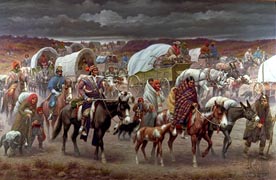
Study Guide
for
U.S. Military History

MAP TEST
In order to pass this course, you are required to demonstrate
a knowledge of US military geography which has shaped and influenced the
history of this nation. Therefore, you will have to pass a map test, administered
in class in the same class period as EXAM #1 or EXAM #2, which will ask
you to locate twenty of the following items on outline maps of the United
States and the world. You must score 16 or more correct out of 20
to pass the test. You may take the map test as many times as are
necessary to pass the test but you MUST
PASS THE MAP TEST BY THE MID SEMESTER POINT IN THE SEMESTER IN ORDER TO
PASS THE COURSE! Maps found in the
textbook will help you study for this map test. All of the following
may be found on the textbook maps. You must be able to locate the
following on the test maps:
| All fifty states by name | Louisbourg | Belgium | Chateau Thierry |
| Quebec | Montreal | Ardennes Forest | Meuse River |
| Ohio River | Mississippi River | Casablanca, Oran & Algiers | Cairo |
| Boston | Lexington & Concord | Sicily | Italy |
| Valley Forge | Saratoga | Salerno | Rome |
| New York City | Philadelphia | Australia | New Zealand |
| Savannah | Cowpens | Guadalcanal | New Guinea |
| Yorktown | Tippecanoe | Coral Sea | Midway |
| Lake Erie | Lake Champlain | Leyete Gulf | Iwo Jima |
| New Orleans | Washington, D.C. | Okinawa | Tokyo |
| Buena Vista | Vera Cruz | Japan | Pearl Harbor |
| Chapultepac | Mexico City | Soviet Union | Moscow |
| Charleston, S.C. | Richmond | Lennigrad | Korea |
| Vicksburg | Gettysburg | Pusan | Inchon |
| Fredericksburg | Chattanooga | Yalu River | South Vietnam |
| Atlanta | Wilmington, N.C. | Saigon | Cam Ranh Bay |
| Santiago, Cuba | San Juan Hill | North Vietnam | Hanoi |
| Manila | Cavite | Ho Chi Minh Trail | Hue |
| France | Germany | Kuwait | Afghanistan |

UNIT #1 Learning Objectives
Introductory Principles
Six Major Themes of U.S. Military History
1. Military considerations alone have rarely shaped
military policy and programs.
2. American military policy has been based on a
pluralistic system of military institutions: professionals, citizen soldiers,
and pacifists.
3. American national security has generally been
well preserved.
4. The country is firmly committed to civilian
control of the military.
5. The armed forces have become more professionalized
and nationalized over time.
6. Industrialization has played a major role in
determining how America fought, especially since the mid-nineteenth century.
Chapter 1
1. Name the two military traditions
most important to the early English colonists.
2. Explain the main principle of the
militia.
3. Explain how the militia functioned.
4. Describe the social characteristics
of militia officers.
5. Discuss how militia control changed
over time.
6. Describe the major concepts of frontier
defense.
7. Explain how the militia was used
as a police force.
8. Describe how colonial military expeditions
were conducted.
9. Describe typical Indian warfare
tactics.
10. Describe typical militia warfare tactics.
11. Discuss Indian conflict in colonial Virginia.
12. Describe the major actions of the Pequot War.
13. Describe the major actions of King Philip's
War.
14. Describe the actions of Bacon's Rebellion.
Chapter 2
1. Explain the British advantages in
the colonial wars in North America.
2. Describe Indian relationships with
both the British and French.
3. Describe the French offensive in
King William's War.
4. Describe the colonial participation
in King William's War.
5. Explain the results of King William's
War.
6. Describe the southern campaign
in Queen Anne's War.
7. Discuss New York's role in Queen
Anne's War.
8. Describe the New England campaign
in Queen Anne's War.
9. Explain the results of Queen Anne's
War.
10. Describe the southern campaign in King
George's War.
11. Explain the northern campaign in King
George's War.
12. Explain the results of King George's
War.
13. Explain the beginning of the French &
Indian War.
14. Describe the early British failures in
the French & Indian War.
15. Describe the British & colonial successes
of the French & Indian War.
16. Explain the results of the French &
Indian War.
17. Summarize the overall conduct of the
French & Indian War.
Chapter 3
1. Explain how the French & Indian War
results led to the American Revolution.
2. Describe the British frontier policy
after 1763.
3. Describe the military events that started
the Revolution.
4. Enumerate the advantages and disadvantages
of Britain and the North American colonies.
5. Explain the "dual army" of the revolutionaries.
6. Discuss George Washington's military
beliefs.
7. Describe the social composition of the
American army.
8. Describe the problems of army administration
& logistics.
9. Discuss the northern campaigns of 1775.
10. Analyze the Middle Atlantic campaigns of 1776.
11. Explain the importance of the Battle of Trenton.
12. Analyze the British campaign of 1777.
13. Explain the importance of French intervention
after Saratoga.
14. Describe the British southern strategy.
15. Differentiate between the American campaigns
of Gates & Greene.
16. Analyze the Yorktown campaign of 1781.
17. Describe the types of navies used by the Americans.
18. Explain why the British agreed to end the war.
Chapter 4
1. Describe the events of 1783 that reawakened
American fears of a standing army.
2. Discuss the Confederation government post-Revolutionary
War military policy.
3. Explain the constitutional doctrines regarding
military policy.
4. Describe early national government military
actions under the Constitution.
5. Discuss Indian relations in the west from 1790-1795
6. Explain the significance of the Whiskey Rebellion.
7. Describe the Federalists' policy regarding
the U.S. Navy.
8. Describe the Federalists' military policy legacy.
9. Describe Jefferson's military policy to 1807.
10. List the factors that led the U.S. into the War of
1812.
11. Explain the U.S. military handicaps in the War of
1812.
12. Describe the opposition to the War of 1812 in the
U.S.
13. List the theaters of war in the War of 1812.
14. Explain the military situation on the Canadian front
in 1812.
15. Describe the role of the U.S. Navy in the War of
1812.
16. Explain U.S. war policy in 1813.
17. Describe the British military offensives in 1814
and their results.
18. Describe the results of the Treaty of Ghent.
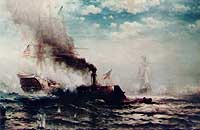
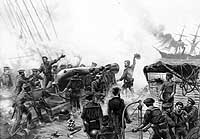
Unit #2 Learning Objectives
Chapter 5
1. Enumerate the three significant developments
that impacted military policy in the 1820's and 1830's.
2. Describe the naval developments in post-War
of 1812 America.
3. Explain the American defense policy of
the 1820's and 1830's.
4. Describe the Army's use of the technology
of the Industrial Revolution.
5. Describe the Navy's use of the technology
of the Industrial Revolution.
6. Describe American military theory of
the 1820's and 1830's.
7. Discuss American military culture after
the War of 1812.
8. Explain the Army's role in westward expansion.
9. Describe the Navy's role in international
relations between 1838 and 1861.
10. Explain the Army's role in Indian relations
in the 1830's.
11. Name Polk's foreign policy problems in 1845.
12. Describe Zachary Taylor's Southern Texas/North
Mexico campaign.
13. Name the groups of Americans who opposed the
Mexican War.
14. Explain Polk's direction of the Mexican War.
15. Describe Taylor's campaign for Monterrey.
16. Describe the Battle of Buena Vista.
17. Describe Scott's campaign to Mexico City.
18. Discuss the Treaty of Guadalupe Hidalgo of
1848.
Chapter 6
1. Compare and contrast the advantages of the two
sides in the Civil War.
2. Explain the war objectives of both the North
and the South.
3. Name the four main theaters of operations.
4. Describe Winfield Scott's "Anaconda Plan."
5. Name the four key tasks of the North in 1861-62.
6. Explain Jefferson Davis' defense strategy.
7. Describe the intitial battles of 1861.
8. Discuss Lincoln's border state policy.
9. Name Lincoln's first triumverant of generals.
10. Name the naval bases captured by the U.S. Navy in
the South.
11. Explain Grant's campaign in Tennessee.
12. Describe the Union spring victories of 1862.
13. Explain McClellan's campaign to get to Richmond in
1862.
14. Describe Lee's counterattack to save Richmond in
1862.
15. Describe Pope's campaign in Virginia in 1862.
16. Describe the Battle of Antietam and its importance.
17. Explain Bragg's Kentucky campaign in 1862.
18. Describe Burnside's Fredericksburg campaign.
19. Describe Grant's first attempt to take Vicksburg.
20. Describe Rosecrans' campaign in Tennessee.
Chapter 7
1. Discuss Black involvement in the militiary from
1862 to 1863.
2. Explain the conscription system.
3. Describe the overview of the 1863 campaigns.
4. Describe Hooker's Chancellorsville campaign.
5. Explain Lee's reaction in the aftermath of
the Chancellorsville campaign.
6. Describe the Battle of Gettysburg.
7. Describe Grant's 1863 Vicksburg campaign.
8. Describe Rosecrans' 1863 Tennessee campaign.
9. Explain the war at sea from northern &
southern perspectives.
10. Describe the logistics problems for both the North
and South.
11. Explain Grant's plan for the 1864 campaigns.
12. Describe the first results of Grant's plan.
13. Describe Grant's overland campaign in Virginia in
1864.
14. Describe Sherman's campaign in Georgia in 1864.
15. Discuss the northern presidential eleciton of 1864.
16. Describe the campaigns of Sherman and Hood in 1864.
17. Describe Lee's last campaign in 1865.
18. List the results of the Civil War.
Chapter 8
1. Explain the position of the military after the
Civil War.
2. Describe the post Civil War return to traditional
missions.
3. Explain US government Indian policy
4. Describe in general terms the Indian Wars matchups.
5. Describe Custer's Last Stand at Little Big
Horn.
6. Describe the US Army's role in the South.
7. Explain the use of the US Army in labor disputes.
8. Describe the beginnings of the New Navy
9. Explain New Navy policy.
10. Describe US coastal defense policy in the 1880's.
11. Describe the developments in US military theory in
the 1870-1890 period.
12. Describe the social changes in the services during
the 1880-1890 period.
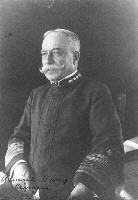

Unit #3 Learning Objectives
Chapter 9
1. Describe U.S.-Spanish relations prior to 1898.
2. Evaluate President McKinley as Commander-in-Chief.
3. Discuss Spain's military position in 1898.
4. Explain the U.S. Navy mobilization of 1898.
5. Explain the U.S. Army mobilization of 1898.
6. Describe the Battle of Manila Bay.
7. Describe the situation of the U.S. Navy in
the Caribbean.
8. Evaluate U.S. Army plans for Cuba.
9. Describe the U.S. Army campaign in Cuba.
10. Describe the actions of the U.S. Navy at Santiago.
11. Describe the Puerto Rico campaign.
12. Describe the situation of the U.S. Army in the Philippines.
13. Discuss the Treaty of Paris.
14. Describe the U.S. Army scandals of the Spanish-American
War.
15. Explain the problems in the Philippines.
16. Describe the actions of the volunteers in the Philippines.
17. Explain the guerrilla warfare in the Philippines.
18. Explain the conquest of the Philippines.
Chapter 10
1. Name the fundamental changes in U.S. defense
policy in 1898.
2. Explain U.S. military policy in 1899.
3. Describe naval developments from 1900-1915.
4. Explain naval base problems of the early 20th
century.
5. Describe the new technologies of the U.S. Navy.
6. Discuss U.S. Army reform of the early 20th
century.
7. Explain U.S. Army manpower changes in the early
20th century.
8. Describe the new technology of the U.S. Army.
9. Describe overseas operations of the U.S. from
1902-1914.
10. List the U.S. preparations for World War I.
Chapter 11
1. Explain U.S. interest in World War I.
2. Describe U.S. seapower & trade patterns.
3. List the fronts of World War I.
4. Explain how the U.S. raised a large U.S. Army.
5. Describe the plans of GHQ AEF.
6. Discuss how the U.S. mobilized its economy
for World War I.
7. Describe the Atlantic campaign.
8. Name other U.S. Navy involvement in World War
I.
9. Evaluate the results of the U.S. Navy campaigns.
10. Explain War Department reorganization.
11. Describe Allied strategy in World War I.
12. List Pershing's problems.
13. Describe initial ground warfare for the U.S. Army.
14. Discuss U.S. supply problems.
15. Describe the U.S. Air Service in World War I.
16. Explain the U.S. counteroffensive of 1918.
17. Describe the Meuse-Argonne offensive.
18. Describe the Allies' view of U.S. contributions.
Chapter 12
1. Describe U.S. defense policy after World War
I.
2. Explain U.S. Navy post-World War I policy.
3. Explain U.S. Army post-World War I policy.
4. Describe U.S. airpower after World War I.
5. Explain the U.S. Navy building program of the
1920's.
6. Describe the role of the USMC in post-World
War I times.
7. Explain the U.S. Army's problems in the 1930's.
8. Explain U.S. Army industrial planning.
9. Describe the U.S. Army's development of tanks.
10. Describe the U.S. Army's development of the Air Corps.
11. Describe naval rearmament of the 1930's.
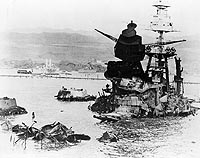

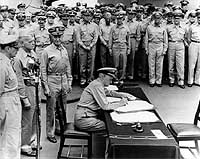
Unit #4 Learning Objectives
Chapter 13
1. Describe the U.S. pre-FDR re-election miltary
plans.
2. Describe the U.S. post-FDR re-election
military plans.
3. Discuss the Atlantic War of 1941.
4. Explain the Japanese threat to the U.S.
in 1941.
5. Describe the Japanese attack on Pearl
Harbor.
6. List the Allied losses in the Asian theater
in 1941-42.
7. Explain the U.S. loss of the Philippines.
8. Describe the U.S. counterattack in the
Pacific in 1942.
9. Describe the U.S. strategic plans for
fighting World War II.
10. Describe the overall U.S. command arrangements.
11. Describe the U.S. economic mobilization for World
War II.
12. Explain how the U.S. financed World War II.
13. Describe U.S. scientific advances that changed the
war.
14. List the Allied intelligence advantages over the
Axis powers.
15. Describe the U-boat war in the Atlantic.
16. Discuss the U.S. campaign in the South Pacific.
17. Explain the North Africa campaign in 1942-43.
18. Discuss the situation in Italy in 1943.
Chapter 14
1. Describe the planning for the Second Front.
2. Describe the Pacific planning in 1944.
3. Evaluate Allied bombing efforts in Europe.
4. Describe how U.S. Pacific forces were
organized.
5. Discuss the 1943-44 Pacific campaign.
6. Describe the Mariana's campaign.
7. Describe the Philippines' campaign of
1944.
8. Explain how Peleliu showed a change in
Japanese tactics.
9. Describe the OVERLORD operation.
10. Explain the Allied advance in western Europe in fall
1944.
11. List Eisenhower's problems in late 1944.
12. Describe the submarine war in the Pacific.
13. Describe the air war against Japan.
14. Discuss the Battle of the Bulge.
15. Describe the liberation of the Philippines.
16. Describe the Iwo Jima campaign.
17. Explain how the war ended in Europe.
18. Explain how the war ended in the Pacific.
Chapter 15
1. Explain the new era in U.S. foreign & military
policy after 1945.
2. Describe the U.S. - Soviet Union rivalry in
the Cold War.
3. List U.S. military shortcomings from 1945-50.
4. Explain the U.S. interservice rivalries of 1948-49.
5. Describe the beginning of the Korean War.
6. Explain MacArthur's role in the Korean War.
7. Describe Truman's rearmament plan of 1951.
8. Explain the formation & role of NATO.
9. Describe the course of the Korean War from 1951-53.
10. Explain how the Korean War ended in 1953.
Chapter 16
1. Explain the post-Korean War defense policy.
2. Discuss the U.S. nuclear deterrence theory.
3. Describe U.S. alliance policies around
the world in the 1950's.
4. Discuss Eisenhower's "New Look" military
policy.
5. Explain Eisenhower's reorganization of
the Defense Department.
6. Discuss Eisenhower's foreign policy from
1953-1959.
7. Explain Kennedy's defense assumptions.
8. Explain the military modernization under
Kennedy.
9. Describe the Berlin crisis.
10. Explain the Cuban situations of 1961-62.
Chapter 17
1. List the costs of Vietnam.
2. Explain the results of Vietnam on U.S.
defense policy.
3. Discuss the background to the Vietnam
War.
4. Describe North Vietnam's leadership and
their policies.
5. Explain Kennedy's policy in Vietnam.
6. Explain Johnson's initial policy.
7. Describe the beginning of the U.S. ground
campaign.
8. Explain the U.S. campaign to 1967.
9. Describe the types of U.S. troops in Vietnam.
10. Describe the role of U.S. airpower in Vietnam.
11. Explain the role of the U.S. Navy in Vietnam.
12. Explain the war against the Viet Cong infrastructure.
13. Describe Johnson's bombing campaign.
14. Evaluate the Tet Offensive.
15. Explain Nixon's plan for ending the war.
16. Explain the North Vietnamese plan for ending the
war.
17. Explain the results of Vietnam on the U.S. military.
18. Describe the concept of coalition defense.
Chapter 18
1. Explain Carter's defense policy.
2. Describe the initial Carter assiumptions.
3. Discuss the Middle East situation between
Egypt and Israel.
4. Evaluate the Iranian hostage crisis.
5. Explain the Reagan defense policy.
6. Describe the Reagan defense budgets.
7. Evaluate Reagan's military policy.
8. Discuss Reagan's last two years in office
defense policy.
9. Describe Bush's defense policy.
10. Describe the Kuwait War.

